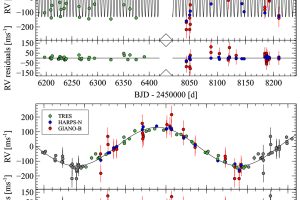Hot Jupiters around young stars. The study: “The GAPS Programme at TNG. XXI. A GIARPS case study of known young planetary candidates: confirmation of HD 285507 b and refutation of AD Leonis b” of I. Carleo (Van Vleck Observatory/INAF-OA Padova) recently appeared on A&A

The discovery of the first exoplanet in 1995 was a challenge to our knowledge of the architecture of planetary systems. The planet orbiting around the star 51 Peg, in fact, was different than the planets in our Solar System: it was a gaseous giant orbiting at only 0.05 Astronomical Units (A.U., where 1 A.U. is the average distance between Earth and the Sun) from its star. The planet 51 Peg b is thus the first “Hot Jupiter” known. Despite we identified today several planets falling in this category, the mechanism formation for the Hot Jupiters is still not known. Several possible mechanisms have been proposed: in-situ formation, migration from wider orbits due to the Kozai mechanism (a periodic oscillation of the eccentricity and inclination of the orbit of a planet), migration within the protoplanetary disk where planets formed, gravitational scattering between planets.
The “Young Object Project“, part of “Global Architecture of Planetary Systems” (GAPS), aims at understanding the formation mechanism leading to massive planets (Jovian and Neptunian) in close orbits by studying planets of this class orbiting around young stars. This is not an easy task, since young stars have a strong magnetic activity, with phenomena such as the photospheric spots that may produce signals that mimic the presence of an exoplanet. To mitigate this contamination, the project is based on simultaneous observations in infrared and optical bands of stellar radial velocity signal (e.g. spectroscopic measurements of the periodic oscillation of stars due to the orbit of their planets). In fact, while the signal produced by stellar spots depends on the wavelength because of the temperature contrast between spots and photosphere, the signal produced by planets is independent from the radiation wavelength.
The study: “The GAPS Programme at TNG. XXI. A GIARPS case study of known young planetary candidates: confirmation of HD 285507 b and refutation of AD Leonis b” of I. Carleo (Van Vleck Observatory e INAF-Astronomical Observatory of Padua), recently appeared on Astronomy & Astrophysics, it the first published paper from the GAPS Young Object Project. The authors have used the spectrographs GIANO-B (infrared) and HARPS-N (optical), mounted on the Telescopio Nazionale Galileo, to measure the radial velocity signal of two young stars known to host a Hot Jupiter and a Hot Neptunian, respectively: HD 285507, one of the Iades stars with an age of 650 million years and a spectral class K4.5, and AD Leonis, a M4.5Ve star with an age between 25 and 300 million years, distant only 16 light years from us. The authors of the study confirmed the presence of a Hot Jupiter around HD 285507, measuring the orbital period equal to about 6 days. This is an important discovery for the developing and confirmation of models of planet formation given that the association of the host star to a stellar cluster results in a precise determination of the age of the system. On the other hand, the radial velocity signal of AD Leonis is chromatic, and thus it is due to stellar activity rather than to the presence of an exoplanet. The astronomers S. Benatti, J. Maldonado, G. Micela, L. Affer e A. Maggio of INAF – Astronomical Observatory of Palermo are coauthors of the study.
The figure (which can be visualized entirely at this link) shows the measurements of radial velocity of HD 285506 obtained with three spectrographs, and the orbital fit.
Mario Giuseppe Guarcello ( follow mguarce)
